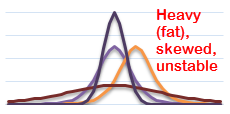AIMs: Explain how asset return distributions tend to deviate from the normal distribution. Explain potential reasons for the existence of fat tails in a return distribution and describe the implications fat tails have on analysis of return distributions. Distinguish between conditional and unconditional distributions

Questions:
323.1. Analyst Peter observes that conditional equity returns exhibit leptokurtosis (i.e., heavy-tail) and negative skewness. Due to time constraints, Peter must use a parametric (analytical) value at risk (VaR) model. Which of the following models is most likely able to model his conditional returns?
a. Normal VaR; i.e., basic so-called delta-normal VaR where portfolio return is a linear function of asset returns that are normal
b. Normal mixture VaR; i.e., portfolio return is a linear function of asset returns that are parametric but characterized by a mixture of normal ("normal mixture") densities
c. Normal GARCH (1,1) VaR model; i.e., Monte Carlo simulation with GARCH volatility
d. Student's t GARCH (1,1) VaR model; i.e., portfolio return is a linear function of asset returns that are characterized (parametrically) by student's t distribution
323.2. Analyst Sue observes that equity returns exhibit leptokurtosis but are symmetrical; i.e., skew is zero. Her value at risk (VaR) model assumes returns are normal. Which of the following errors is most likely?
a. Her VaR model will neither under- nor over-estimate the actual VaR
b. Her VaR model will under-estimate VaR at all confidence levels
c. At low (high) confidence levels her VaR model will over-estimate (under-estimate) actual VaR
d. Her VaR model will over-estimate VaR at all confidence levels
323.3. Analyst Mark samples a window of equity returns and observes their unconditional distribution exhibits heavy-tails. According to Linda Allen et al, which of the following explanations is most plausible?
a. The conditional returns cannot be normal
b. The mean return likely varies over time, due to efficient markets, which in turn creates unconditional heavy-tails
c. Conditional returns must be normal due to the central limit theorem (CLT), but the volatility is probably time-varying
d. In addition to time-varying volatility which itself implies heavy-tailed unconditional returns, conditional returns are probably non-normal also
Answers:

Questions:
323.1. Analyst Peter observes that conditional equity returns exhibit leptokurtosis (i.e., heavy-tail) and negative skewness. Due to time constraints, Peter must use a parametric (analytical) value at risk (VaR) model. Which of the following models is most likely able to model his conditional returns?
a. Normal VaR; i.e., basic so-called delta-normal VaR where portfolio return is a linear function of asset returns that are normal
b. Normal mixture VaR; i.e., portfolio return is a linear function of asset returns that are parametric but characterized by a mixture of normal ("normal mixture") densities
c. Normal GARCH (1,1) VaR model; i.e., Monte Carlo simulation with GARCH volatility
d. Student's t GARCH (1,1) VaR model; i.e., portfolio return is a linear function of asset returns that are characterized (parametrically) by student's t distribution
323.2. Analyst Sue observes that equity returns exhibit leptokurtosis but are symmetrical; i.e., skew is zero. Her value at risk (VaR) model assumes returns are normal. Which of the following errors is most likely?
a. Her VaR model will neither under- nor over-estimate the actual VaR
b. Her VaR model will under-estimate VaR at all confidence levels
c. At low (high) confidence levels her VaR model will over-estimate (under-estimate) actual VaR
d. Her VaR model will over-estimate VaR at all confidence levels
323.3. Analyst Mark samples a window of equity returns and observes their unconditional distribution exhibits heavy-tails. According to Linda Allen et al, which of the following explanations is most plausible?
a. The conditional returns cannot be normal
b. The mean return likely varies over time, due to efficient markets, which in turn creates unconditional heavy-tails
c. Conditional returns must be normal due to the central limit theorem (CLT), but the volatility is probably time-varying
d. In addition to time-varying volatility which itself implies heavy-tailed unconditional returns, conditional returns are probably non-normal also
Answers:
